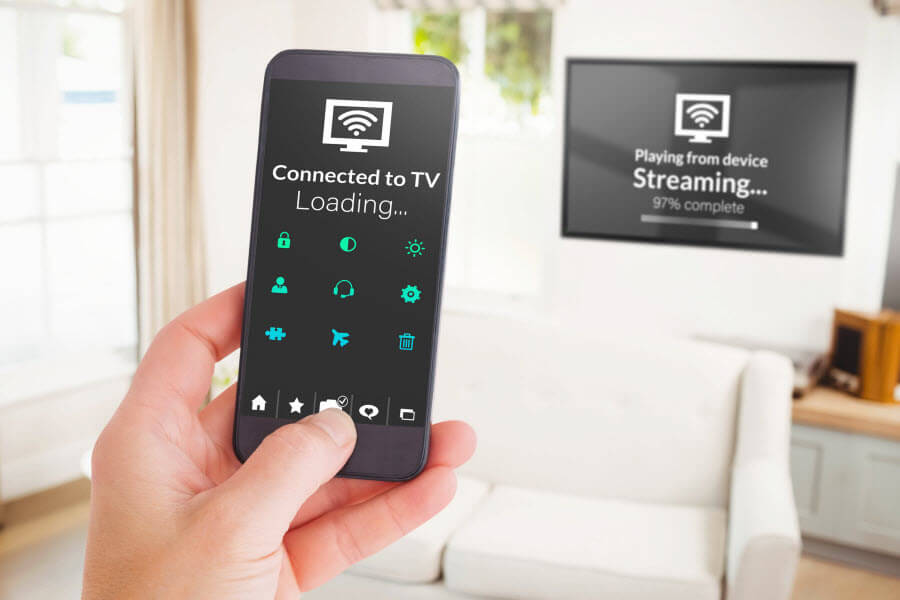Rich colors, high-fidelity sounds, images in motion and the ability to reach a wide audience once made TV advertising the clear-cut leader in marketing channels. That is, before the rise of the internet and proliferation of smart things.
With a lot of luck, we’re talking lottery luck, TV advertising can still turn a relatively unknown name into a household name. The “big break” opportunity TV advertising promises is what makes this marketing method compelling to many small business owners. It’s also what makes TV advertising cost 10 to 30 times more than radio and print ads.
To maximize the chance for a solid return on your investment (ROI) in a TV commercial, your ad needs to run enough times that, eventually, it plays in front of enough people in your target demographic. It doesn’t stop there. The content of your TV commercial must then motivate the viewer to do business with you.
For prices that are just a fraction of a TV commercial, direct mail advertising can reach your target demographic and drive them to action. Unlike TV advertising, where changes to the content (rewrites, reshoots, etc.) or time slot can cost thousands of dollars, each direct mail campaign you run can easily be tweaked based on your marketing need to meet, and very often exceed, your ROI goals.
Direct Mail Targeting and Tracking
It’s not just affordability that makes direct mail marketing a powerful complement for TV advertising or even the superior choice when your marketing budget is tight. There’s also direct mail’s ability to target ads at shoppers prequalified by years of consumer research – research that grows with each mailing. Direct mail is cost-effective marketing that doesn’t squander your ad dollars by broadcasting your business to households too far away to pay attention (or care). With direct mail advertising, you can:
- Target local households by demographics, geography and purchasing behaviors
- Valpak’s audience has a 20% higher purchasing power
- Only mail to high-income consumers with discretionary income to spend
- Consumers who receive Valpak have 32% higher incomes1
- Tailor your message by audience (new, current and past customers)
- Valpak’s smart envelope enables household-level targeting
- Analyze and optimize ad performance to ensure no wasted spend
- Marketing ROI tools from Valpak track response/performance
Direct mail marketing answers many of the questions left unanswered or insufficiently addressed by TV advertising. How many consumers saw your ad? Did they really see your ad, or did it play for an empty couch? What actions did they take after your ad aired somewhere in their household?
With the right direct mail company, you can measure consumer response to your print advertising – thanks to tracking codes, URLs and phone numbers unique to your campaign. You’ll know which households redeemed your offers and when. You’ll know if a household looked online for more information about your ad or business. And you’ll know when and why a prospective customer calls.
With the scattershot approach of TV advertising, advertisers can’t pick which streets or neighborhoods receive their ads – the entire TV market will receive them.
What happens when you don’t have fine control over where your brand’s message goes and who receives it?
Home services companies waste money marketing to apartment complexes. Maid services squander marketing dollars advertising to hotels. Pizza shops entice someone on the other side of town to get their pizza fix at a much closer parlor.
Consumer Response
While more than half of baby boomers (55%) primarily get their news from broadcast and cable TV, it’s another marketing channel that drives them to act: direct mail.
About a third of boomers (33%) responded to a direct mail ad in the past 30 days, compared to 27% for TV ads (includes over-the-air, mobile video and web video) and 22% for newspaper ads (includes print, web and mobile ads).
And contrary to the conventional knowledge of just a few years ago, millennials enjoy receiving direct mail too, with 31% responding to an ad in their mailboxes in the past 30 days.
Direct Mail Response Rates
Responded to an Ad in the Mailbox in the Past 30 Days2
- Baby Boomers: 33%
- Gen Xers: 33%
- Millennials: 31%
- Gen Zers: 21%
Through more than 50 years of local marketing expertise, Valpak continues to lead the industry in direct mail response and engagement:
- 90% of households open the Valpak Blue Envelope
- 82% look at every local ad inside it
- 54% use Valpak coupons once a month or more
- 71% set aside 1-4 coupon ads to share or use in the future3
TV Cord Cutting and the Rise of Streaming
Something of a novelty early on and a bit of a hobby a little later, cord cutting has become a way of life for millions of consumers in the U.S. In 2018, eMarketer forecasted U.S. cord cutters to reach 33 million, a 32.8 percent increase over the previous year.
While many cord cutters don’t cut the coax cable altogether, it’s still needed to connect to antennas for over-the-air channels, the lifestyle change to streaming and on-demand content continues to eat away at the potency of TV advertising.
The money saved on opting out of cable TV packages is either banked or spent elsewhere. So, if cord cutters aren’t watching the premium ad slots on pay TV, where are they finding deals that resonate and prompt them to purchase now? The answer: They’re responding to coupons and ads in their mailboxes.
28% of cord cutters responded to a direct mail ad in the past 30 days. Direct mail ads are trailed in response rates by sponsored internet search results (25%), email ads (24%), ads on social networks (23%) and television ads (23%).
TV Advertising Costs
From hiring talent to shooting and editing your commercial, TV advertising has significant upfront costs. Once your commercial is ready to air, costs continue to rise when you choose the station, time of day and coverage area of your TV spot. Obviously, most small business owners aren’t vying for airtime during Monday Night Football or other high visibility nationwide programs. The average cost per thousand (CPM) for national broadcast networks is $31.97. The cost of a local TV spot is easier to swallow, averaging between $200 and $1,500 for a 30-second ad. This does not include upfront production costs.
Let’s say you own a Mexican restaurant. If you run a 30-second local TV ad each week in a month period, your advertising cost ranges from $800 to $6,000. If 50 people come into your restaurant after viewing your ad in a given month, your cost per lead (CPL) could be up to $120. Is your average order $120?
Compare this CPL to Valpak, which costs as little as pennies per household per monthly mailing. Using 3 cents as the average, for Mexican restaurants, we recommend you mail 30,000 targeted homes around your location. That equals $900 per month – up to $5,100 less than a month of TV advertising.
If 50 people come into your restaurant in response to your Valpak ad, your monthly CPL is $18 (up to 85% less than TV).
Now, let’s look at an industry with higher average order value and lower consumer demand.
Let’s say you own a roofing company and 5 people call after hearing your TV ad. Your CPL could be up to $1,200. The average homeowner spends $7,568 on a new roof, so TV advertising is a viable marketing investment for your business… but Valpak is better!
If you run Valpak’s recommended quantity of 100,000 targeted homes in your service area, you’ll spend $3,000 per month – up to 50% less than TV advertising.
If 5 people call your roofing company, your monthly CPL is $600 (50% less than TV).
A Bundle of Synergy with TV & Direct Mail
Here’s the major takeaway from all this: TV ads work, but they can cost too much for many small and midsize businesses. Direct mail delivers more bang for each advertising buck, with hyper-targeting and tracking capabilities that TV advertising simply can’t compete with.
For those set on making TV ads part of their marketing campaigns, it’s important to not overlook the synergies realized by combining this form of marketing with other channels. Those households free of cable cords or that have opted to keep TV out of the living room entirely, might be some of your best customers. You just need the right marketing firm to help you identify them.
When you consider consumers’ tendency to skip commercial breaks, the continued rise of premium streaming services, the staying power of direct mail marketing and the sheer cost of TV advertising, a compelling conclusion emerges: You probably shouldn’t abandon other forms of marketing in favor of going all in on TV advertising.
1. Compared to the average U.S. consumer. Claritas data with current year projections. January 2019.
2. 2018 AudienceSCAN
3. Among households that receive Valpak. 2018 Valpak® Readership Study, Research Now®, December 2018.




